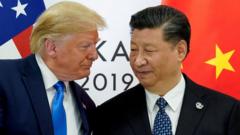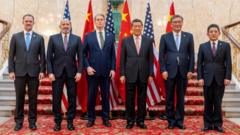President Trump announced a preliminary agreement with China to roll back certain trade restrictions, allowing both countries to ease measures imposed in the wake of escalating economic tensions. The deal involves China's commitment to lift some restrictions on rare earth shipments, while the U.S. will reconsider its visa policies for Chinese students. However, the overall impact on existing tariffs remains minimal.
U.S. and China Reach Agreement to Ease Trade Tensions

U.S. and China Reach Agreement to Ease Trade Tensions
After two days of discussions in London, the U.S. and China have reportedly made strides to mend their economic relationship, albeit with limited progress on tariffs.
The U.S. and China have taken a notable step in easing rising economic tensions, culminating in a two-day meeting in London where both parties announced a preliminary agreement. President Trump declared that they have “struck a deal” to roll back some of the recently imposed punitive measures that have strained their trade relationship.
As part of the agreement, China is expected to ease restrictions on the export of rare earth minerals and magnets, essential for several industries in the United States. In return, the U.S. government will refrain from enforcing visa restrictions on Chinese students and will relax certain constraints on exports to China. Specific details about the agreement are yet to be disclosed.
Trump took to social media to share his enthusiasm for the deal, stating it is “done, subject to final approval with President Xi and me,” emphasizing the positive state of the relationship between the two nations.
The backdrop of this agreement lies in the escalating economic tensions that became pronounced after Trump introduced a series of tariffs in April. These tariffs represented a significant strain on businesses across both countries, with concerns escalating over potential shortages of goods in American retail spaces later this year.
Despite the progress, current tariffs between the U.S. and China remain unchanged, and there will be a 90-day pause on implementing certain tariffs, expiring in August. Officials from the U.S. trade representative noted that while both sides would maintain communication, a further meeting has yet to be scheduled.
Analysts have pointed out that this agreement primarily serves to alleviate some of the consequences stemming from the president’s own trade policies without signaling substantial advancements toward a comprehensive trade deal. According to Ana Swanson, who specializes in trade and economics, “It appears to merely unwind the damage and escalation from the president’s own trade war.” Thus, while the outcome of the talks has provided a sense of optimism, significant challenges remain unaddressed in U.S.-China trade relations.























